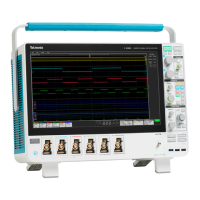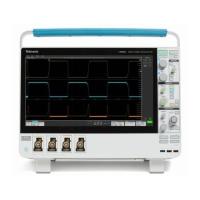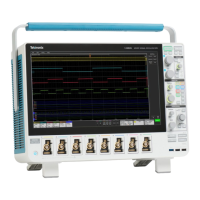Guidelines for working with math waveforms
Use the following guidelines when working with math waveforms:
■
Keep math waveforms simple. If the math expression becomes too complex, try separating the expression into more than
one math waveform and then combining the waveforms (for example, Math1 = Math2 + Math4).
■
Math calculations are not available on digital channels.
■
Math waveforms cannot be turned on without a math expression.
■
To avoid syntax errors in a math expression, verify the use of operators, parentheses, operands, and the spelling of
functions.
■
If one or more reference waveforms are used in a math waveform, the record length is equal to the smallest of all the source
waveforms (reference, math, or channel waveforms). The math is calculated using the first point from each source, followed
by the next point, and so forth. This is true even if the sources have different times between points in the record.
Math waveform editor syntax
You can build math waveforms using the predefined expressions or the equation editor. To help you create valid math
waveforms, the following tools will block most illegal entries by disabling any window element that would create an invalid entry in
the math waveform expression.
Predefined expressions are accessible using the FFT or Basic Math Types.
The following syntax describes the valid math expressions you can use with the Equation Editor for the Advanced Math Type:
A math expression is composed of settings, functions, scalars and sources.
Settings have the syntax [settingName=settingValue] and are generally applied to measurements. The setting applies to
everything to the right of the closing square brackets.
Example: [CoefFileName="highpass_0.25bw.flt"]HighPass(Ch1)
CoefFileName is the setting and is used as the high pass filter on channel 1.
Example: [CoefFileName="highpass_0.25bw.flt"] HighPass(Ch1) + [CoefFileName="lowpass_0.05bw.flt"] LowPass(Ch2)
The high pass filter file is applied to channel 1 and lowpass_0.05bw.flt is applied to channel 2.
Functions, except for basic and logic functions, have the syntax function(source).
In the previous examples the functions are HighPass and LowPass.
Basic and logic functions have the syntax
source1 function source2.
Examples: Ch1 * Ch2
Ch1 AND Ch2
Ch1 >= Ch2
Logic functions, ==|<|>|!=|<=|>=|AND|OR|NAND|NOR|XOR|EQV result in a waveform consisting of binary 0 and 1 values.
Scalars can be integers, floating point values, PI or meas<x>.
Sources can be Ch<x>, Ref<x>, Math<x>
Measurement concepts
MSO54, MSO56, MSO58, MSO58LP, MSO64 Help 435

